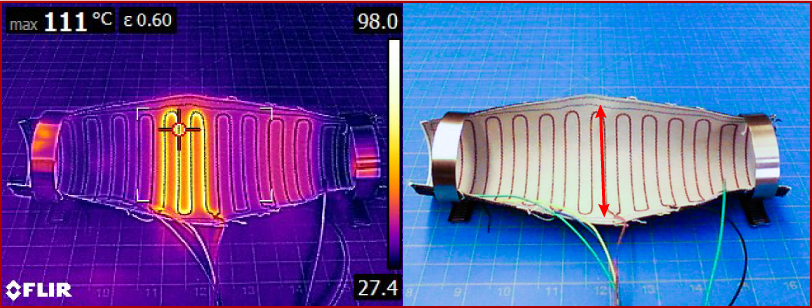In our latest paper we leveraged the anisotropic properties of curved sheets to create reconfigurable joints. Imagine a flat material like a thin piece of paper. This piece of paper can be stiffened by curving it along a single axis into a U-shape. In this case the anisotropic property is that it resists bending along the curve due to increased stiffness in the remaining axis. This stiffness can be reduced by creating a small change in shape along the curve such as creating a temporary flat spot or crease, which results in a reduced stiffness at that point meaning the curved paper can bend there.
We used shape-memory alloy (SMA) wire sewn into some denim and stiff plastic using tailored wire placement to form a “crease” when energized which creates a flexure hinge, allowing the structure to bend. Since we are able to electronically control where this crease is formed we can create a hinge up and down the structure, meaning we can reconfigure the location of the joint.
Here’s the proceeding:
1525082
B7AJWMLX
items
1
chicago-author-date
0
default
asc
1731
https://harnettlab.org/wp-content/plugins/zotpress/
%7B%22status%22%3A%22success%22%2C%22updateneeded%22%3Afalse%2C%22instance%22%3A%22zotpress-1b15b39f424fc49b50dacc25b1dd4e20%22%2C%22meta%22%3A%7B%22request_last%22%3A0%2C%22request_next%22%3A0%2C%22used_cache%22%3Atrue%7D%2C%22data%22%3A%5B%7B%22key%22%3A%22B7AJWMLX%22%2C%22library%22%3A%7B%22id%22%3A1525082%7D%2C%22meta%22%3A%7B%22creatorSummary%22%3A%22Bupe%20et%20al.%22%2C%22parsedDate%22%3A%222022%22%2C%22numChildren%22%3A0%7D%2C%22bib%22%3A%22%3Cdiv%20class%3D%5C%22csl-bib-body%5C%22%20style%3D%5C%22line-height%3A%201.35%3B%20padding-left%3A%201em%3B%20text-indent%3A-1em%3B%5C%22%3E%5Cn%20%20%3Cdiv%20class%3D%5C%22csl-entry%5C%22%3EBupe%2C%20Paul%2C%20Douglas%20J%20Jackson%2C%20and%20CK%20Harnett.%202022.%20%26%23x201C%3BElectronically%20Reconfigurable%20Virtual%20Joints%20by%20Shape%20Memory%20Alloy-Induced%20Buckling%20of%20Curved%20Sheets.%26%23x201D%3B%20In%20%3Ci%3EProceedings%20of%20IEEE%20SoutheastCon%202022%3C%5C%2Fi%3E%2C%20598%26%23x2013%3B604.%20IEEE.%20%3Ca%20href%3D%27https%3A%5C%2F%5C%2Fpaperpile.com%5C%2Fshared%5C%2F4soDRu%27%3Ehttps%3A%5C%2F%5C%2Fpaperpile.com%5C%2Fshared%5C%2F4soDRu%3C%5C%2Fa%3E.%3C%5C%2Fdiv%3E%5Cn%3C%5C%2Fdiv%3E%22%2C%22data%22%3A%7B%22itemType%22%3A%22conferencePaper%22%2C%22title%22%3A%22Electronically%20Reconfigurable%20Virtual%20Joints%20by%20Shape%20Memory%20Alloy-Induced%20Buckling%20of%20Curved%20Sheets%22%2C%22creators%22%3A%5B%7B%22creatorType%22%3A%22author%22%2C%22firstName%22%3A%22Paul%22%2C%22lastName%22%3A%22Bupe%22%7D%2C%7B%22creatorType%22%3A%22author%22%2C%22firstName%22%3A%22Douglas%20J%22%2C%22lastName%22%3A%22Jackson%22%7D%2C%7B%22creatorType%22%3A%22author%22%2C%22firstName%22%3A%22CK%22%2C%22lastName%22%3A%22Harnett%22%7D%5D%2C%22abstractNote%22%3A%22%22%2C%22date%22%3A%222022%22%2C%22proceedingsTitle%22%3A%22Proceedings%20of%20IEEE%20SoutheastCon%202022%22%2C%22conferenceName%22%3A%22%22%2C%22language%22%3A%22%22%2C%22DOI%22%3A%22%22%2C%22ISBN%22%3A%22%22%2C%22url%22%3A%22https%3A%5C%2F%5C%2Fpaperpile.com%5C%2Fshared%5C%2F4soDRu%22%2C%22collections%22%3A%5B%22GXXIZJ7F%22%5D%2C%22dateModified%22%3A%222022-12-29T00%3A56%3A03Z%22%7D%7D%5D%7D
Bupe, Paul, Douglas J Jackson, and CK Harnett. 2022. “Electronically Reconfigurable Virtual Joints by Shape Memory Alloy-Induced Buckling of Curved Sheets.” In
Proceedings of IEEE SoutheastCon 2022, 598–604. IEEE.
https://paperpile.com/shared/4soDRu.
This project is part of the SCRAM consortium, supported by NSF award 1935324.

